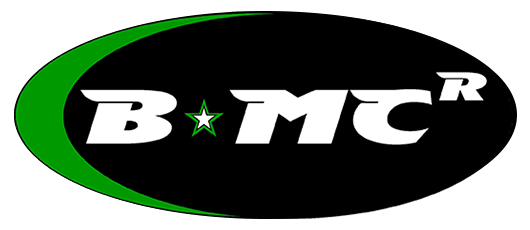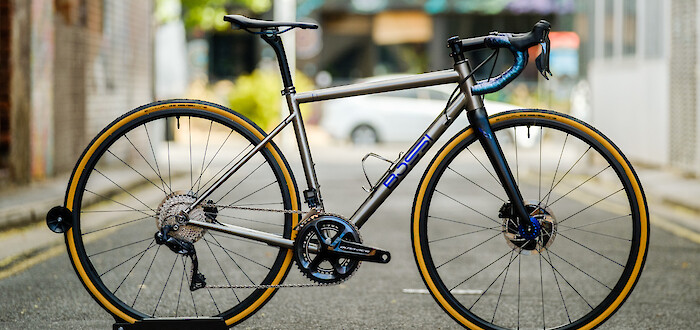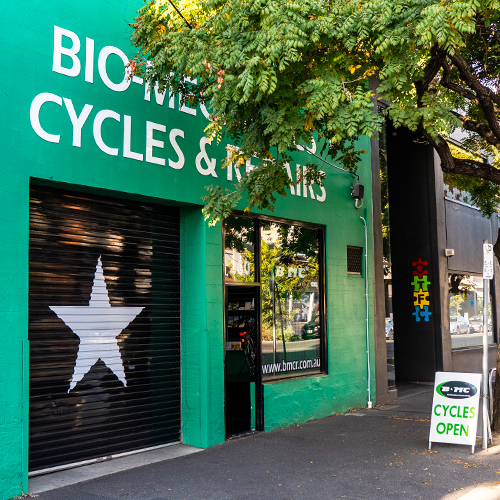Is frame facing necessary?


The ultimate guide to bicycle frame facing
What is frame facing, and what does it actually do?
Hasn't my pricey frame already been faced by the factory?
I know a guy who said that you can't face carbon or titanium frames -- is that right?
What difference does it make, anyway?
With four decades of bicycle assembly and frame machining experience under our belt, we've heard all of the myths and misconceptions about facing. Facing can be one of the most important things you can do for your bike—and your wallet—so why don't more people do it?
Let's take a look at this commonly misunderstood area of the bike industry, and sort out the facts from fiction.
We'll also discover why so many shops don't bother with it, and why they should at least consider it.
What is facing?
Facing is the process of machining a surface to remove excess material so it’s perfectly flat and set to the correct specified angle.
Facing requires specialist tools, which are applied to the frame—usually by hand—to shave down the surfaces.
These tools need to be lubed with cutting oil to increase the lifespan of the cutter and ensure a better overall result. (We make our own in-house, but there are many different compounds and oils you can buy off the shelf.)

What is chasing?
This is where you've probably heard the phrase ‘facing and chasing’. The 'chasing' part refers to cleaning out the threads of a frame where the bottom bracket screws in.
These two processes aren't always done at the same time — there are many manufacturers who make individual tools for this area. We tend to do chasing and facing at the same time, however, as the taps are integrated into our particular cutting tool.

What areas need to be faced?
There are three main areas on a bicycle frame which require facing:
- Bottom bracket. This is the big one, as this area is a major culprit when it comes to noises: clicks, ticks, squeaks, clunks and grinding – basically stuff you don’t want to be hearing while you’re riding.
- Head tube.
- Disc brake mounts.
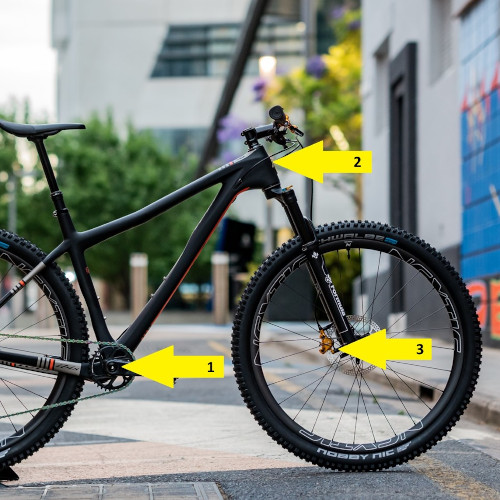
There’s also the fork crown and head stem, but we’ll get to these later.
Why does facing need to be done?
Poorly faced frames can develop a multitude of problems, many of which aren’t necessarily apparent at first.
To begin with, a bottom bracket shell needs its surfaces to be perfectly flat and parallel. If they are, everything fits together perfectly, and runs quietly and smoothly. When the surfaces aren’t flat and/or parallel, the bearings can easily twist or be side-loaded by the crank axle. This can lead to play or movement in the cranks and uneven loading on the bearings. In addition to accelerated wear on parts – which means you’re spending more money sooner than you otherwise would have, hurray – the area also can feel rough and be noisy. (Yes, that’s possibly the elusive click that’s driving you bonkers on every ride.)
It's not just screw-together bottom bracket systems that benefit from proper frame facing, too. Facing is also important for press-fit bottom brackets to ensure that the bottom bracket lip sits flush against the frame, again eliminating any noises.

For the head tube, facing will ensure that the bearings sit parallel and aren’t getting twisted. This helps the headset bearings last longer and also helps your forks turn more smoothly. Like the bottom bracket, the head tube can be a source of clicking or knocking noises if the bearings don’t perfectly mate to their seats (the recessed area inside the head tube that Pete is handily pointing to in the below shot). A common giveaway of unparallel surfaces is if your headset continually comes loose, even after re-tightening it for the umpteenth time.
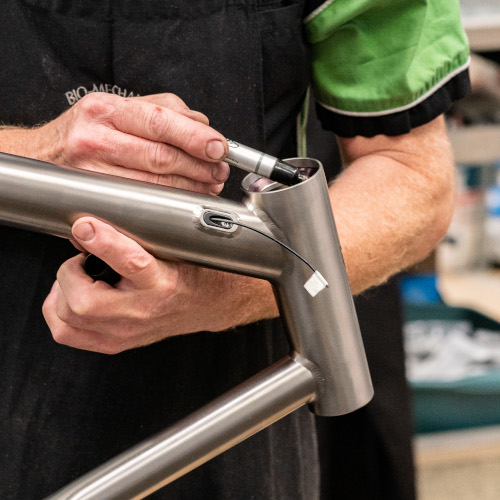
Disc brake mounts are an area that people don’t often think about, but they’re just as important when it comes to facing. If the mounts aren’t flat, parallel and perpendicular to the line of the disc rotor, the likely result will be rubbing between the pads and rotors, uneven wear on the pads, and/or noisy braking. It can also give a less solid feel through the lever.
We see a lot of bikes come into the workshop with disc brake issues which could have been avoided if the mounts were properly faced to start with, so it’s certainly something you don’t want to skip.

Do new frames need to be faced?
All frames should be faced, even new ones. Just because your frame is new doesn’t mean it’s been done properly – or at all.
Most frames—regardless of price (more on that in a moment)—come out of the factory with surfaces which are less than perfect when it comes to machined flatness. This is primarily due to production processes; most factories are under pressure to produce a certain number of frames (e.g. a lot) in a certain amount of time (e.g. not much). The level of fine detailing that proper facing requires takes time, and therefore increases the costs involved. As a result, it’s an area that tends to get either scrimped on or skipped altogether.
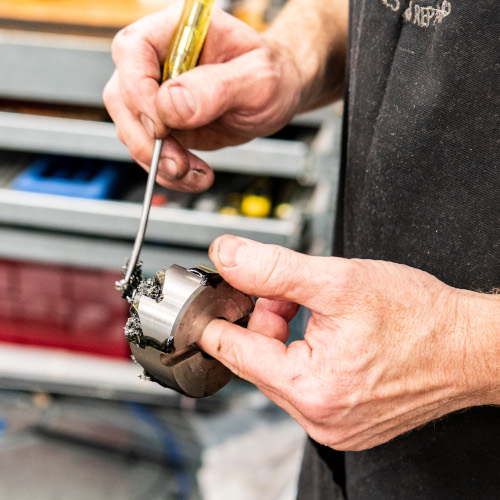
Why are surfaces not square to begin with, anyway?
If a bicycle frame is made of metal, during the welding process the tubes expand and contract in a way that isn’t uniform. This results in high and low spots, as well as the ovalisation of tubes.
With carbon fibre, carbon sheets are laid out in a mould. That mould is then pressurised to remove excess resin (which is the glue that sticks it all together). Because of the curing process, however, the ends of the tubes and bearing seats don’t tend to come out of the mould in perfect condition.
So whether you’re running a steel, aluminium, titanium or carbon frame, they all benefit from being properly faced. (You may have heard a popular bicycle YouTuber say that the last two can’t actually be faced. We’ll tackle that inanity in a moment.)
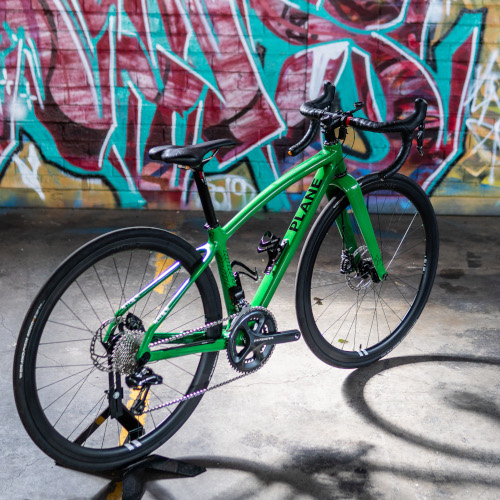
What about fork crowns and head stems?
We’ve covered the big three areas, so why do we also look at fork crowns and head stems?
The bearing preload force is delivered by the top cap, so it stands to reason that all surfaces between the top cap and the fork crown need to be parallel to each other to deliver an even load to the bearings themselves. You can see from the pictures below that even good-quality head stems can benefit from facing.
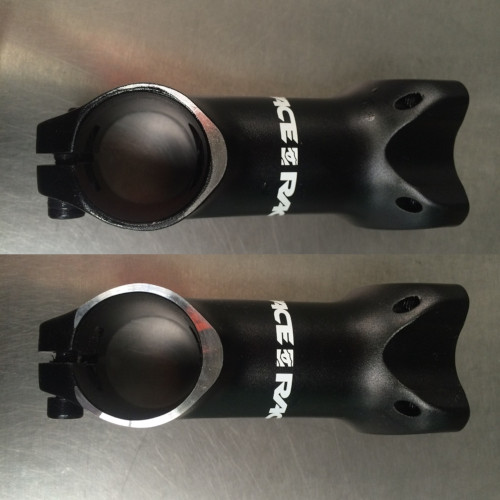
Do you also face headset spacers?
While we have experimented with facing headset spacers, we’ve found it’s not necessary.
Firstly, spacers are usually quite flat. Secondly, because of their nature, headset spacers can sit together in a way that doesn’t create uneven loads in the bearings.

How do you face a frame?
You need specialist tools to face a frame, and there are two factors which determine the end results:
- The quality of the tool.
- The skill of the mechanic.
There are some horrible facing tools on the market, and the cheap ones simply aren’t worth the money. These tools can actually create more problems than they solve due to the inaccuracies in the production of the tool itself. It’s hard to get a good result if the tool you’re using isn’t actually made to the right tolerances.
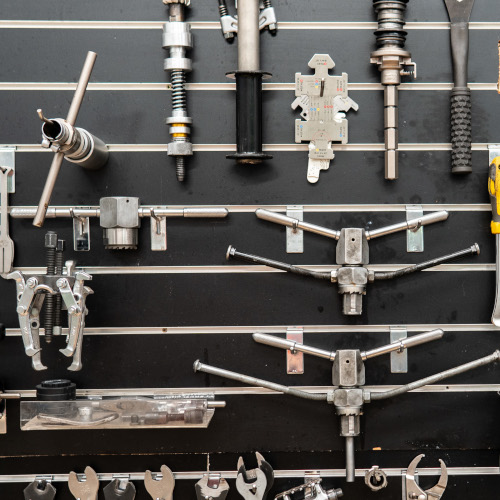
Some bike shops don’t want to spend the required money on high-end facing tools because they don’t consider it to be an important—or even necessary—part of the process, or don’t think they’ll use the tools enough to make it worth their while.
To put it in perspective, the facing tools we have in the BMCR workshop are worth many thousands of dollars. They were one of our first big purchases, which actually was pretty scary back in the day when BMCR was still just a one-man operation in a tiny shop. However, we knew the importance of investing in these kinds of tools and how much of a difference they would make to the service we could provide. And we were right. While many of them will never pay for themselves, having these tools enables us to fix problems that very few other people can.
We’re also always looking for ways to improve our processes and increase our tool collection, such as our latest acquisition below: a custom-made diamond-plated carbon fork facing tool. Here's Pete explaining a bit more about it.
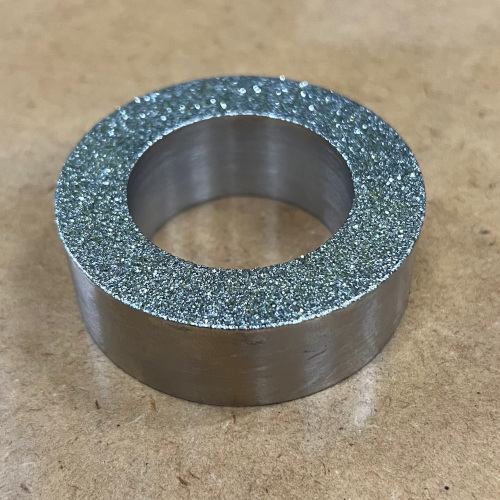
How long does it take to face a frame?
The time a frame will require is very hard to gauge: it entirely depends on how badly out of square the frame is, as well as the frame material itself.
Chromoly steel and aluminium are more friendly materials for cutters to work with. The process slows down dramatically when it comes to titanium, however, and slows down even further when we’re looking at carbon fibre, as these two materials are much harder. (For example, a carbon set of disc mounts that have been moulded badly can take an hour or more.)
Carbon in particular is a very abrasive material, and very quickly dulls the edge of a traditional cutter -- hence our recent exploration into diamond-plating custom tools. Diamond-plating abrades the surface and enables us to deliver the same quality we’ve been able to achieve using traditional tools but without the tools suffering excessive wear.
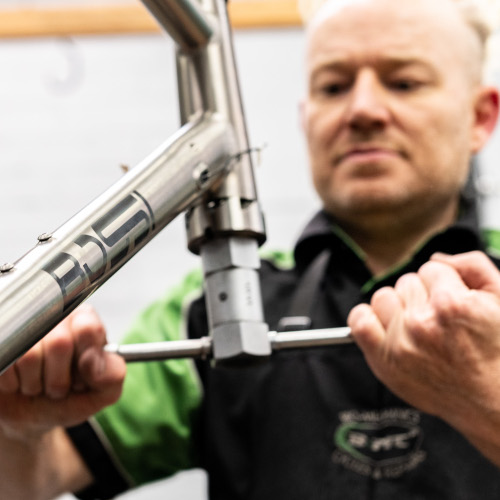
Even if you find a shop with high-quality facing tools, they still need to be operated by someone who knows what they’re doing, and is willing to take the time to do it properly. We have seen hundreds of frames which have apparently been already been faced, but either have been sloppily done or still have excess material that needs to be removed.
Moreover, if a frame has been faced with cheap tools, the damage created by those tools can mean that we need to do a greater amount of remedial work than would otherwise have been required. This is particularly frustrating if you’re the one whose frame needs to be faced again – essentially, you’ve had to pay for the work twice.
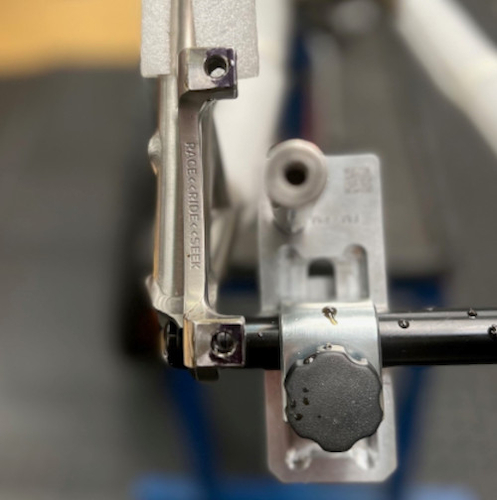
Can I face my frame myself? I’m pretty good with a file.
No.
Or, yes, then make a time to bring it to us to fix the damage.
How do I know if my frame needs to be faced?
There are a couple of tell-tale signs:
- After your local bike shop has serviced your bike, it's nice and quiet for a ride or two but then the clicks and noises start up again.
- You're going through bearings at an unnatural rate. (For example, it's not normal to replace bottom bracket bearings two or three times a year.)
- Your headset keeps loosening off, regardless of how many times you tighten it up.
- Components keep coming loose or developing knocking noises.
While it's not guaranteed that uneven frame surfaces are the only culprit at play here, it's very often the case that inaccuracies in frame facing are contributing. In any rate, your frame will never be worse off for having been properly faced.
(Of course, if you've bought it from us, it's already been done.)
How often does facing need to be done?
Only once, if it’s done properly. (See point above.)
When faced correctly the first time, the frame never needs to be done again. Hurray!

But my bike shop/mechanic/forum/some YouTube commentor doesn’t think facing is necessary.
To say that frame facing isn’t necessary comes down to an inherent lack of education in the bicycle industry.
We need to look at the industry as a whole. Most store owners are primarily retailers. Their point of focus is to sell you a bike and accessories. There’s nothing wrong with this, of course, but it also means that that particular shop’s workshop isn’t necessarily their highest priority, and mechanical expertise may not be on the radar. (This is assuming, of course, that this shop even has a full workshop; quite a few are primarily just assembly areas. Many shops would also remove the workshop side of things all together if they could; it’s a much harder way to make money than just selling you a bike.)
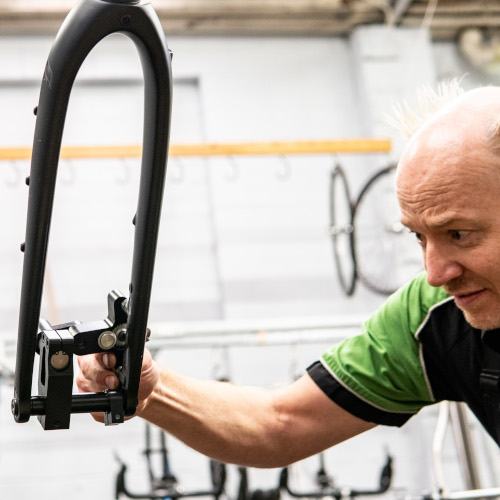
Even with a workshop, many store owners also don’t necessarily see or understand the importance of the level of precision that we endeavour to achieve in our workshop here. They don’t therefore see the relevance in facing a bicycle frame unless there is a catastrophic mismatch in components, in which case they’re more likely to pursue a warranty path rather than try to remedy it themselves.
We’re the polar opposite of most stores in that we’re primarily repair-focused, so we’re far more engaged with these sorts of issues rather than trying to assemble bikes as quickly as possible and then worry about potential warranty issues at a later date.

Here’s a fun industry fact: one popular bicycle store chain pays its mechanics according to how many bikes they assemble; the faster they can do it, the better -- quality control isn't even part of the equation, which is why we hear so many stories of pedals falling off or handlebars going sideways on the first ride. In contrast, even our most entry level bikes still take 3-4 hours to assemble because every frame goes through the facing process before it leaves our store. (The high-end ones can take up to 10 hours.) This in itself means that most bikes we sell are sold at or below cost, which for a regular retailer is an unsustainable model.
Please note that we’re not bagging other shops for not being focused on the workshop side of things. Everyone has to play to their strengths, and everyone has to try to survive in an industry which has traditionally been undervalued (and still is, to a large extent… but that’s a blog post for another time).
We’re just explaining why – whether through lack of expertise, time or understanding – your local shop may downplay the idea that facing isn’t important, when it absolutely is.
OK! Let’s bust some myths.

Myth: carbon and titanium cannot be faced
This is categorically – and demonstrably – untrue. We have physically proven it time and time again in the workshop. It is more difficult to face these materials, as we’ve previously explained, but it’s absolutely possible, and also possible to a very high standard of quality.
So, we don’t care how many views your Youtube channel has: you’re wrong, dude.
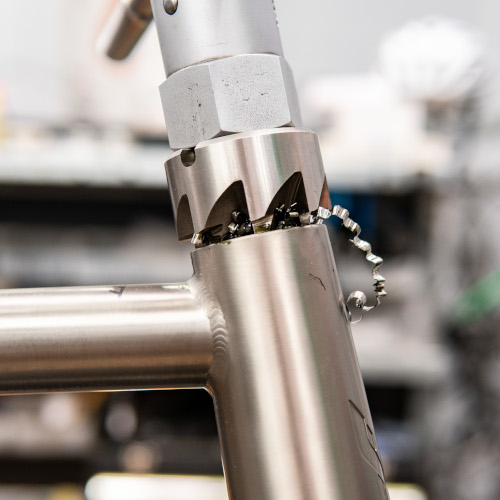
Myth: expensive frames have already been faced
It would be nice to think that your super-expensive top-of-the-range frame has been lovingly hand-crafted by artisanal mechanics, but we often see pricey frames with crappy or nonexistent facing. Conversely, we’ve also seen some cheap frames where the facing has been done properly. (Consistency, thy name is not the bicycle industry.) It really comes down to the individual factory and the pride they take in the end result.
Possibly the worst frame we’ve ever had to work on was a crazy-high-end German hand-produced carbon frame. It was astonishingly poorly finished, and to rectify each individual area of the frame took many hours.
All in all, the retail price of a frame isn’t as tied to the quality as you might expect.

Myth: Facing doesn’t make a difference
This is also untrue. To claim that facing makes no difference means that you’re suggesting that having two components that fit together perfectly isn’t any better than two components that don’t fit together perfectly.
What is up for debate is whether the rider has the sensitivity to notice the difference between a frame that’s faced and one that isn’t – it’s down to the individual. However, every rider will notice it in the future costs of repairs (e.g. bearings that last longer), the quietness of the ride (e.g. fewer clicking noises), and the more solid feel through the bike.
Basically, there’s a chance you may not notice it while you’re riding but you’ll certainly notice it when it comes to maintenance costs down the track.

Myth: Facing voids the warranty
This is a tale that’s sometimes peddled by bike forum hobgoblins or by shops who either don’t have the tooling or don’t understand the necessity of the process. It’s absolutely not correct, and some brands even specify that it should be done prior to assembly.
In the hands of an expert, there is absolutely nothing to fear in getting your frame faced.
So is facing a bicycle frame really necessary?
Although facing is theoretically not critical, it will always give a better result than a frame that’s not faced.
If you want your bike to perform at its best, last longest and be as quiet as it can be, get it done.
You’ll never regret it.
Have a frame that needs some tender loving machining? We can look after it.
The video that started it all. Thanks, Ride Adelaide!
